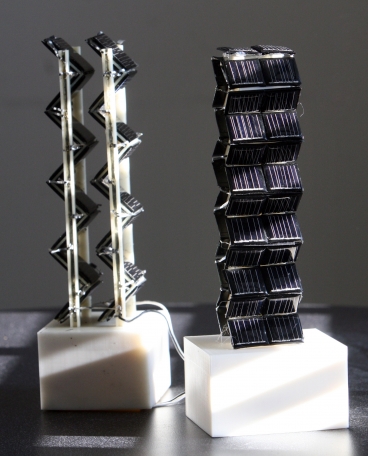Solar goes 3D in MIT research project

Researchers at the Massachusetts Institute of Technology (MIT) are experimenting with an approach that could see future solar installations configured in a three-dimensional design, instead of in the flat-panel format that springs to mind when someone mentions an installation.

Small-scale models of the three-dimensional solar photovoltaic arrays being tested on an MIT rooftop. (Photo by Allegra Boverman)
The concept, which the MIT researchers discuss in the journal Energy and Environmental Science, places solar cells in what you could describe as a tower. (Check out the photo for two different examples of hypothetical models.)
The idea behind the research is that the vertical surfaces in these tower designs will be able to capture more sunlight as an energy-generating source in the mornings, evenings and during the winter, when the axis of the orbit brings the sun closer to the horizon. This creates an installation that provides a more predictable and uniform source of power throughout the year, according to the MIT research.
The drawback? It apparently would cost more to design 3-D module configurations like the ones that the MIT researchers are testing. Still, the researchers believe that over the course of time, that expense would be factored out because the installation would provide a more predictable source of power.
"Even 10 years ago, this idea wouldn't have been economically justifiable because the modules cost to much," wrote the senior author of the MIT paper, Jeffrey Grossman, who is the Carl Richard Soderberg Career Development Associate Professor of Power Engineering at MIT.
The MIT researchers noted that while other projects are studying the potential impact of 3-D panel installations, their research is attempting to approach the problem with a systematic approach in order to determine its economic viability. The team is using both computer models, as well as real-world experiments with roof-top tower structures in order to collect their data.
The accordion design on the right in the above picture could prove particularly interesting, because the design would help cut down on installation time -- at least in theory. The tower can be folded flat, for easier shipping and then opened up at the installation site.
So far, the research (focused on three different tower designs) has shown that the tower designs can produce a power output that is at least double that of fixed flat panels installed with the same base footprint.
(Photo by Allegra Boverman, courtesy of MIT)